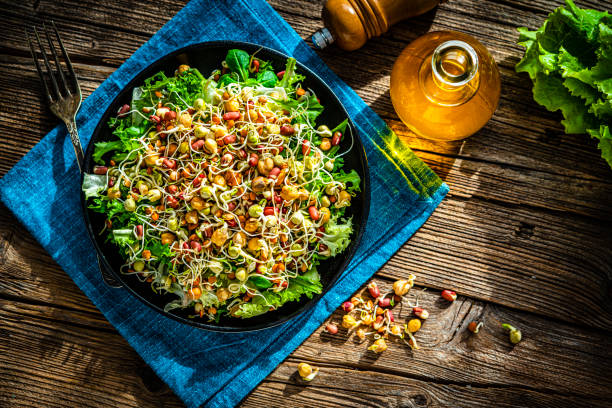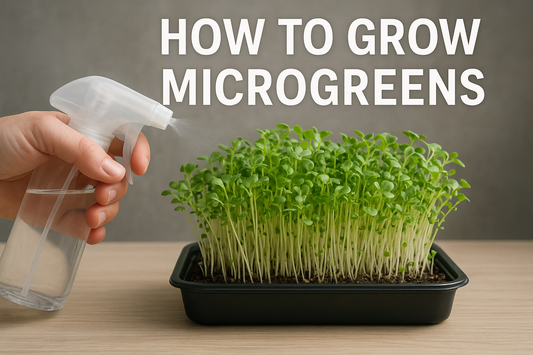
What Are Sprouts?
Share
Sprouts are one of the easiest and healthiest ways to enrich your diet with fresh, living food. They are packed with vitamins, enzymes, antioxidants, and easily digestible proteins. Growing sprouts does not require special equipment or advanced skills — just a few simple steps. Within a few days, you can enjoy your own fresh sprouts, perfect for vegetarians, vegans, and anyone seeking a conscious, healthy lifestyle. But what exactly are sprouts, how do they differ from germinated seeds, and why are they often called a superfood? Let’s find out.
Sprouts or Germinated Seeds?
Many people ask: Sprouts or germinated seeds? While the terms are often used interchangeably, there is a difference:
- Germinated seeds (also called “sprouts”) are seeds that have just started to grow after soaking. Usually, on day 1–2, they develop a tiny white root.
- Sprouts are the next stage, when the seed produces a green shoot with its first leaves. At this stage, photosynthesis begins, and the nutrient content increases significantly.
Microgreens sprouts are especially valued, as they contain far more vitamins and minerals than mature plants. They are tender, juicy, and have a wide range of flavors — from neutral to slightly spicy or nutty.
How to Grow Sprouts at Home – Step-by-Step Guide
Sprouting seeds at home is simple and requires only a few essentials:
- High-quality microgreen seeds (organic, untreated, high germination rate).
- Clean water.
- A jar with a mesh lid, a sprouting container, or a multi-tier sprouter.
- A warm place (20–23 °C / 68–73 °F) without direct sunlight.
Step-by-step process:
- Soak: place seeds in water for 6–12 hours.
- Drain & rinse: rinse thoroughly and transfer to a sprouting jar or container.
- Care: rinse 2–3 times per day to prevent drying and mold.
- Wait: within 3–7 days (depending on the variety), sprouts are ready to eat.
- Harvest: when the first green leaves appear, cut and enjoy fresh.
Tip: For extra crunch, refrigerate your sprouts for a few hours before eating.
History of Sprouts
The history of sprouts goes back thousands of years. In Ancient China, they were used to prevent scurvy thanks to their high vitamin C content. In India, sprouts were considered a source of vital energy. Today, they are part of the global trend toward superfoods and living nutrition, gaining popularity as a natural source of concentrated nutrients.
Nutritional Value and Health Benefits
Sprouts are nutrient powerhouses. Their nutrients and health benefits include:
- Vitamins: A, C, E, and B-complex to strengthen immunity.
- Minerals: calcium, magnesium, iron, and zinc to support bones and metabolism.
- Proteins & amino acids: essential for energy and muscle growth.
- Fiber: promotes healthy digestion.
- Antioxidants: protect cells from oxidative stress.
- Enzymes: improve nutrient absorption and gut health.
Regular consumption of sprouts supports immunity, reduces inflammation, improves skin and hair health, and boosts energy naturally.
Popular Types of Sprouts
There are many types of sprouts, but the most common and beneficial ones include:
- Broccoli sprouts: rich in sulforaphane, a powerful compound for cell protection.
- Radish sprouts: spicy flavor and high vitamin E content.
- Pea shoots: excellent source of plant protein and vitamin K.
- Alfalfa sprouts: mild taste, rich in fiber and chlorophyll.
- Cress: fast-growing (3–4 days), loaded with vitamin C and iodine.
Combining different sprout varieties provides even more benefits. For example, broccoli + radish enhances sulforaphane production, while pea + cress boosts energy without caffeine.
Sprouts – Eat Them Raw or Not?
A common question is: Should you eat sprouts raw? The healthiest way is to enjoy them raw, since this preserves the maximum amount of vitamins and enzymes. People with sensitive digestion can briefly blanch them with hot water or add them to warm dishes at the very end of cooking. This way, they keep most of their flavor but may lose some nutrients.
How to Use Sprouts in Cooking
Sprout uses in the kitchen are incredibly versatile:
- Add them fresh to salads, soups, and grain bowls for crunch.
- Blend into smoothies for a nutrient boost.
- Use in sandwiches, wraps, and as a topping for fresh bread.
- Garnish warm dishes such as pasta, curries, or Asian-style stir-fries.
- Combine with microgreens for maximum nutritional effect.
Whether raw, lightly heated, or used as a garnish, sprouts add freshness, taste, and nutrients to almost any dish.











